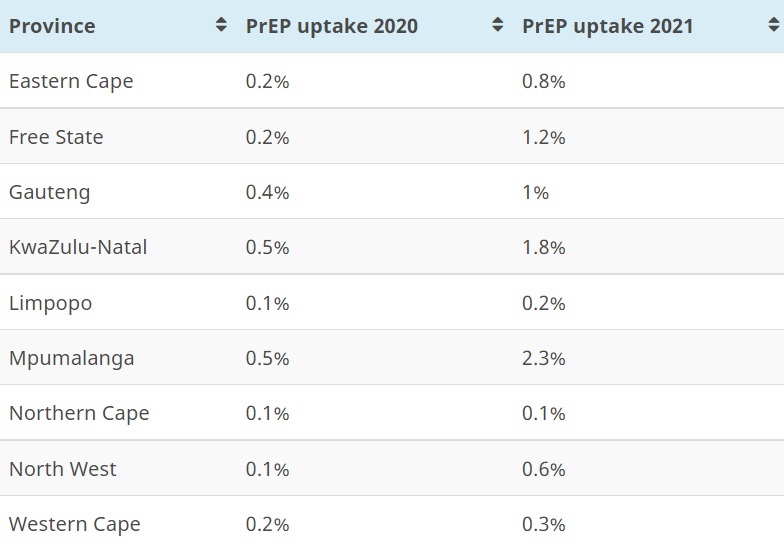- When taken as prescribed, PrEP is highly effective for preventing HIV.
- Despite this, uptake by sexually active people in the Western Cape are worryingly low.
- One of the reasons for this is because PrEP is not available in a very accessible way, says prof Linda-Gail Bekker.
It is estimated that in 2021, only around 0.3% of sexually active people in the Western Cape were taking antiretroviral medicines to prevent HIV infection. When taken as prescribed, such pre-exposure prophylaxis (PrEP) is about 99% effective at preventing HIV infection.
The Western Cape ranks seventh among South Africa’s nine provinces on this measure – only Limpopo and the Northern Cape are doing worse. Mpumalanga is in the lead at 2.3%, followed by KwaZulu-Natal at 1.8%, and Gauteng at 1%. The estimate for South Africa as a whole is 1%. The figures are from the latest published outputs of Thembisa, the leading model of HIV in South Africa.
PrEP uptake
Provinces differ substantially in terms of the size of their population, how easy the population is to reach, how young the population is, and how many people are living with HIV – and with that the extent to which uninfected persons are at risk of contracting HIV.
It is, for example, plausible that lower HIV rates in the Western Cape may be one factor contributing to lower cumulative demand for PrEP in the province.
Low availability?
One reason for the low PrEP uptake in the Western Cape might, however, simply be that PrEP is available at comparatively few clinics in the province.
According to Byron la Hoe, spokesperson for the Department of Health and Wellness in the province, only 60 (18%) out of 336 facilities in the province are currently reporting on their PrEP rollout.
National Department of Health spokesperson Foster Mohale recently told Spotlight that nationally, by April 2022, 68% of facilities were providing PrEP – a full 50 percentage points higher than in the Western Cape.
READ MORE | New HIV PrEP strategy to drastically reduce infections
“Since the inception of the programme [in 2016], PrEP began at selected clinics and health facilities across South Africa,” says la Hoe. “The scale-up of PrEP was meant to take place in four phases for the 191 primary healthcare facilities in the Western Cape at the time. The selection of health facilities for phase 1 was based on impact, population reached, and sub-district coverage.”
While getting systems put into place at national level during Phase 1, he says, the province relied on the district support partners (service delivery NGOs) in the Metro to implement PrEP at certain high-burden sites.
“There were no rural sites implementing [PrEP] at this point. Furthermore, due to Covid-19, scale up to Phase 2, 3, and 4 was delayed. A provincial circular was signed off at the end of May 2022 and progress is now being made in the programme,” says La Hoe.
Is demand lower in the WC?
In 2021, there was an estimated 198 000 new HIV infections in South Africa, of which 18 000 were in the Western Cape. The percentages, however, tell a more nuanced story.
In 2021, 8.3% of people in the Western Cape were living with HIV compared to 13.5% nationally and HIV incidence in the province in 2021 was estimated at 0.29% compared to 0.39% nationally. On the whole, the risk of contracting HIV in the Western Cape is thus lower than in the rest of the country.
But, as Professor Linda-Gail Bekker, Chief Executive Officer at Desmond Tutu Health Foundation, points out, in some communities and for many young people in the Western Cape, the risk of HIV acquisition is just as high as anywhere in the country.
READ MORE | ‘Not enough youth in KZN make use of new HIV PrEP pill’ – Health MEC
“We may have less burden overall but when the virus is circulating in a sexual network then individual risk is high regardless of which province they live in,” she says, adding:
“In a country with the greatest burden of HIV anywhere in the world and with young women experiencing the rates of HIV incidence that are still occurring today, all young people in South Africa should have access to PrEP if they so desire. We also need to make sure we have made young people aware of this intervention and make it accessible.
Bekker adds: “Ideally, it should also be available at non-clinic community-based outlets as well. In the same way, we should be making contraception easily accessible to young women if we really want the rates of unintended pregnancy also to reduce.
“I think it has been a lower priority than HIV treatment provision, which made sense a decade ago but now the emphasis should be on prevention scale up.”
The province’s plans
La Hoe doesn’t beat around the bush when it comes to the challenges faced by the PrEP programme in the province. “Demand has been low due to PrEP not being easily accessible, being predominantly partner-driven, and not having received buy-in from all levels,” he says.
“Providing easy and unrestricted access to PrEP drugs, along with community-supported education campaigns to inform when PrEP use would be advised and when not, which we refer to as risk-informed PrEP use, could help to realise the benefits of PrEP and could help to increase the demand. Making PrEP easily accessible in the community for all will require buy-in at all levels,” says La Hoe.
He continues: “In some settings, this access should be community-led, with the many potential advantages that this approach has for sustained access and support for PrEP users.”
The department has specific target groups for the PrEP programme (as per national guidelines). They are:
- Adolescent girls, boys, young women, and men
- Men who have sex with men
- Individuals with more than one sexual partner
- People who inject drugs
- People with a recent history of sexually transmitted infections
- Individuals who recognise their own risk and request PrEP
- Sero-discordant couples (an intimate partnership in which one person is HIV-positive and the other is HIV-negative) if the HIV-positive partner is not virally suppressed
- Sex workers
- Migrant workers
- Pregnant and breastfeeding women
Not just for the Western Cape
Sibongile Tshabalala, National Chairperson of the Treatment Action Campaign (TAC), is critical of government’s efforts to provide PrEP so far, both in the Western Cape and nationally.
“We hope to see an improvement in uptake when injectable PrEP is made available in South Africa,” she says. Currently, PrEP is only available in pill form in the public sector – an injection that provides two months of protection per shot is expected to be registered soon.
While PrEP was first introduced in South Africa in 2016, it is only in the last two years that provision and uptake have picked up. One reason for the slow rollout is that the initial focus was exclusively on “key populations” such as sex workers. It is only over the last two years that a more general national rollout has gathered some momentum.
But even if the pills are available in clinics, issues of privacy, confidentiality, stigma, and discrimination can still be a barrier to uptake. As recently reported by Spotlight, how to best make PrEP available to different groups of people remains something of an open question.
READ MORE | 5 things you should know about PrEP
La Hoe says that offering PrEP at different types of locations could be a suitable delivery model for young people. This may mitigate barriers, such as transportation, long distance to dispensing sites, and negative healthcare worker attitudes. This can be especially important for young women and girls – a group in which HIV incidence has remained stubbornly high.
Logistical barriers
Bekker points out that across South Africa’s provinces some logistical barriers remain.
“We have just had this (PrEP) approved for use in antenatal care, we now need to train midwives and get the word out there. Ideally, we should be retesting pregnant women for HIV during their pregnancy and then offer them testing and PrEP on delivery during the post-partum period as well. If a pregnant or breast-feeding woman becomes HIV-infected, her rapid increase in viral load makes vertical transmission a very big risk.”
Another barrier, Bekker points out, is that in South Africa only nurses with special accreditation may provide PrEP. “There is no obvious reason why nurses need to have this accreditation. These nurses are limited in our public sector clinics. There is a high turnover of them and it provides another huge barrier,” she says.
*This article was published by Spotlight – health journalism in the public interest.




 Publications
Publications
 Partners
Partners














